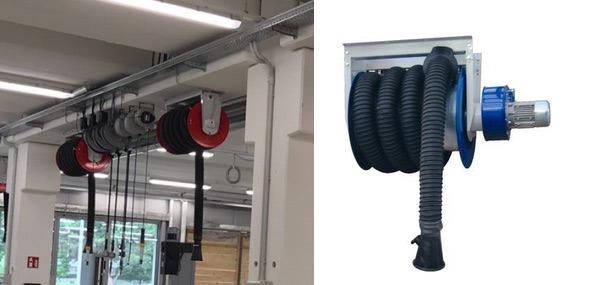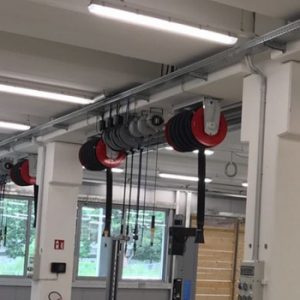
Exhaust gas extraction requires a system that allows, thanks to an extractor and a pipeline, to suck the polluting gas directly from the exhaust terminal of the vehicle to the outside of the workshop. Let’s find out which.

The exhaust gases emitted by vehicles during the different phases of work in car repair shops exposes staff to an often underestimated risk. In fact, even modern combustion engines generate harmful exhaust gases that are not visible to the human eye. When vehicles are enclosed within spaces, exposure to emissions becomes hazardous to persons and workers.
Normally the phases of exposure to the exhaust gases in workshops or car dealers are:
For this occupational exposure is known that D.Lgs. 81/08 provides for health surveillance based on the risk assessment of exposure to carcinogens such as, For example, vapors of petrol and hydrocarbons for auto-traction or fumes and exhaust gases in which oxides of nitrogen (NO, NO2), sulfur dioxide (SO2) and carbon monoxide (CO) are also present which may result in indoor pollution from polycyclic aromatic hydrocarbons (PAHs).
So the answer is yes. In these cases, the only solution is to equip yourself with individual exhaust gases or a suction system, both designed and dimensioned according to specific working needs.
Exhaust gas suction requires a system that allows, thanks to an extractor and a pipeline, to suck the polluting gas directly from the exhaust terminal of the vehicle to the outside of the workshop. It seems simple, but to do it professionally you must first evaluate it better:
|
 |
Once you have addressed the issues above, you should also remember that the flexible pipe where the exhaust gases pass, is normally at least 10 meters long and that is usually heavy and bulky, so it can certainly not stay on the ground or around the workshop.
One of the products that best solves these problems is the exhaust gas hose reel with built-in extractor, practical and smart solution with these added values:
This type of solution is available in different configurations depending on the diameter of the hose that changes in the various types of vehicles to be served, such as motorcycles, cars or trucks. The size of the extractor on board also changes depending on the type of medium, such as the length of the suction hose, depending on the rolling position or location to be served.
We must be very careful about this parameter. There are often exhaust gas extractors that do not guarantee the minimum guaranteed flow, whose value is recommended at European level by EGEA, the European Association of Workshop Equipment.
Below are the approximate values of the recommended air flows to obtain a correct exhaust gas suction:
Car up to 4000 cc cylinder capacity with max 2500 rpm/min = 450 m3/h flow (normal service)
Car up to 4000 cc cylinder capacity with max 5000 rpm/min = 900 m3/h flow (exhaust gas test phase)
Trucks up to 16,000 cc cylinder capacity with max 1300 rev/min = Flow rate 1000 m3/h (normal service)
Trucks up to 16,000 cc cylinder capacity with max 2500 rev/min = Flow rate 1800 m3/h (exhaust gas test phase)
For other applications, such as performance testing or special vehicle testing, case-by-case testing is required.
Contact our technical department without obligation for information or visit the exhaust category in our website to choose the most suitable one!
Fill in the form below to request a quote by email, agree on special conditions, or technical clarifications